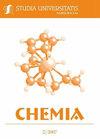Carbon dioxide removal using ammonia in biogas upgrading and purification
IF 0.5
4区 化学
Q4 CHEMISTRY, MULTIDISCIPLINARY
引用次数: 1
Abstract
An alternative source of energy like biogas has become of interest to reduce the dependence on depleting fossil fuels for the source of energy. It is environmentally friendly and can be generated from various biomass wastes. It consists of CH4 (55%65%) and CO2 (35%45%) with a calorific value of 22 00025 000 kJ/m3 when raw and after CO2 is removed, the methane gas has a calorific value up to 39 000 kJ/ m3 and is referred to as biomethane. Ammonia is used as an absorbent in chemical scrubbing to remove CO2 from biogas. A continuous system consisting of 1L digester was used for biogas production which was bubbled through an absorbent in 500mL gas washing bottle at a constant temperature in a water bath. The obtained biomethane potential was found to be 0.387 m3 CH4/ kg VS which simply means that more methane gas can be obtained when using ammonia for absorption. An increase in the gas flow rate leads to an increase in the mass transfer coefficient resulting in an increase in the rate of absorption. The initial CO2 concentration affects the removal efficiency because more work needs to be done for biogas with a high initial concentration of CO2. NH3 has better absorption capacity because higher biogas purity was achieved at lower NH3 concentration. The removal efficiency for NH3 increased from 69%-79% on average with CH4 concentration reaching over 85% vol. This is equivalent to a calorific value ranging from 2533.5 MJ/Nm3 which is promising in terms of the gas ability to run in an automobile engine.沼气升级净化中氨法去除二氧化碳的研究
像沼气这样的替代能源已经引起人们的兴趣,以减少对消耗化石燃料的能源依赖。它是环保的,可以从各种生物质废物中产生。它由CH4(55% - 65%)和CO2(35% - 45%)组成,热值为22 000 - 25 000 kJ/m3,当原料和去除CO2后,甲烷气体的热值高达39 000 kJ/m3,称为生物甲烷。在化学洗涤中,氨被用作吸收剂,以去除沼气中的二氧化碳。采用由1L沼气池组成的连续系统生产沼气,将沼气放入500mL气体洗涤瓶中,在恒温水浴中通过吸收剂起泡。得到的生物甲烷势为0.387 m3 CH4/ kg VS,这意味着使用氨吸收可以获得更多的甲烷气体。气体流速的增加导致传质系数的增加,从而导致吸收率的增加。初始CO2浓度影响去除效率,因为初始CO2浓度高的沼气需要做更多的功。NH3的吸收能力较好,因为在较低的NH3浓度下,沼气纯度较高。当CH4浓度达到85% vol以上时,NH3的去除率平均从69%提高到79%。这相当于热值在2533.5 MJ/Nm3之间,这在汽车发动机的气体运行能力方面是有希望的。
本文章由计算机程序翻译,如有差异,请以英文原文为准。
求助全文
约1分钟内获得全文
求助全文
来源期刊
CiteScore
0.80
自引率
33.30%
发文量
25
审稿时长
>12 weeks
期刊介绍:
Studia Universitatis Babes-Bolyai, Seria Chemia publishes fundamental studies in all areas of chemistry and chemical engineering.
Coverage includes experimental and theoretical reports on quantitative studies of structure and thermodynamics, kinetics, mechanisms of reactions, inorganic, organic, organometallic chemistry, biochemistry, computational chemistry, solid-state phenomena, surface chemistry, chemical technology and environmental chemistry.

 求助内容:
求助内容: 应助结果提醒方式:
应助结果提醒方式:


